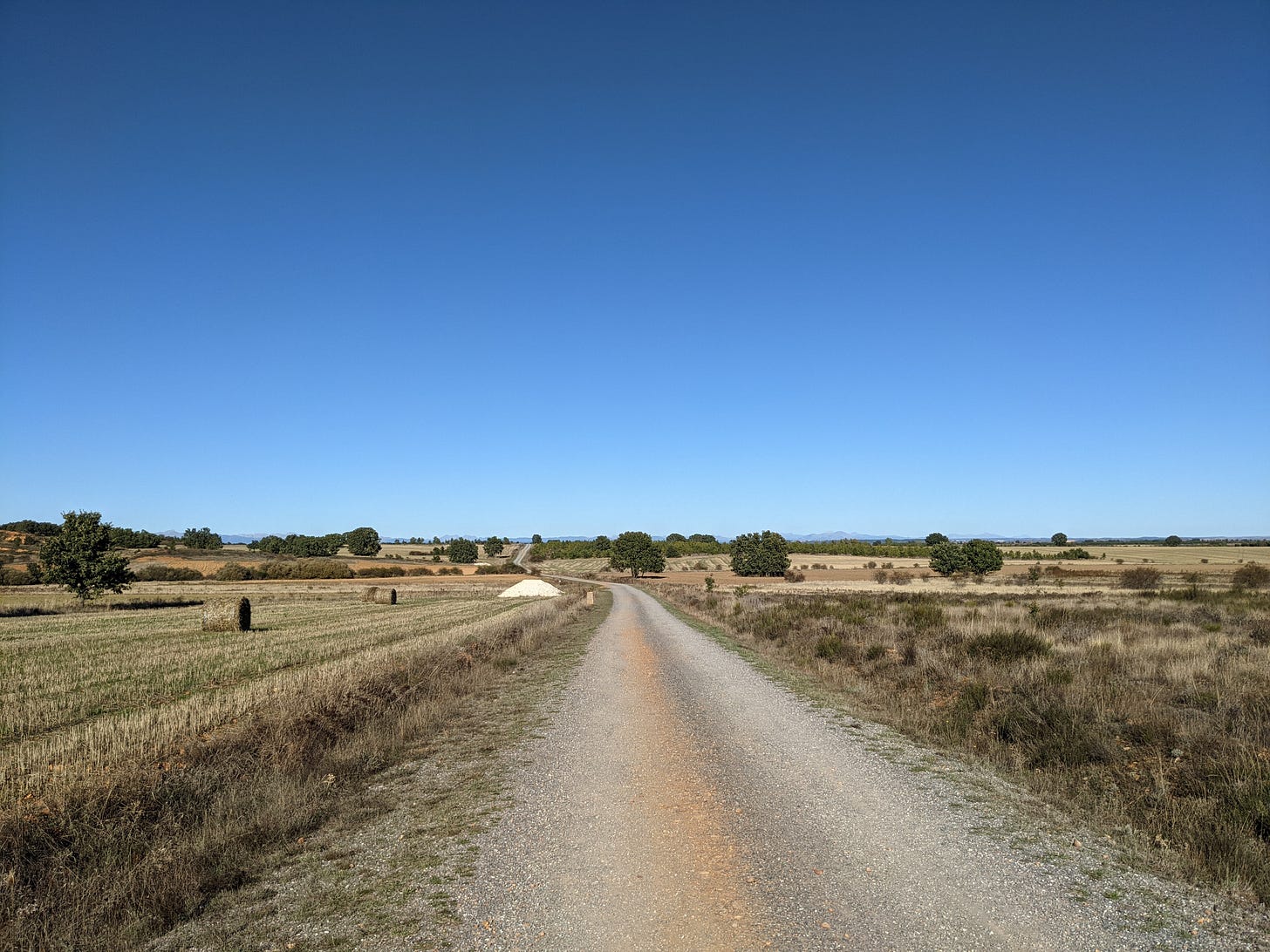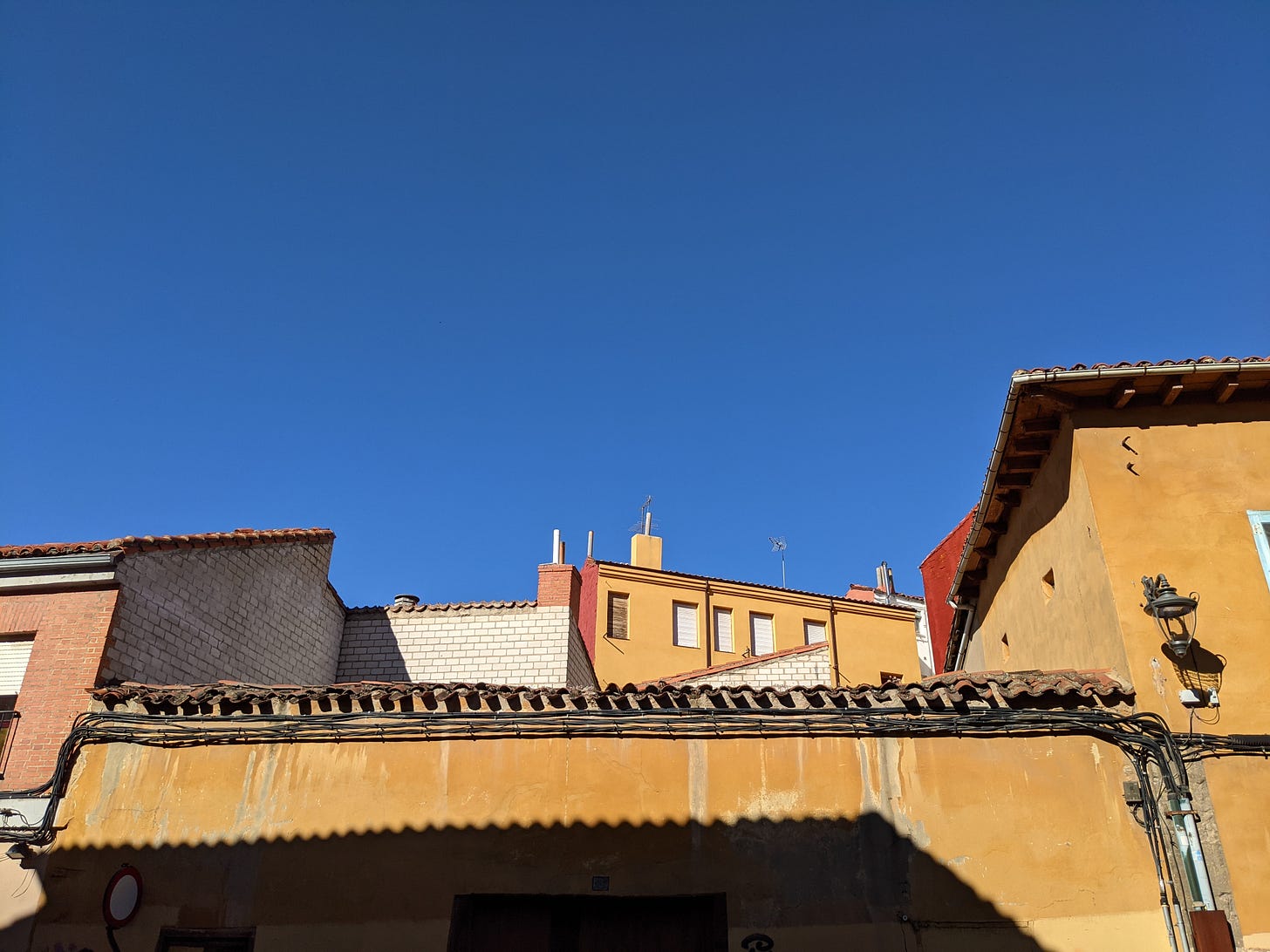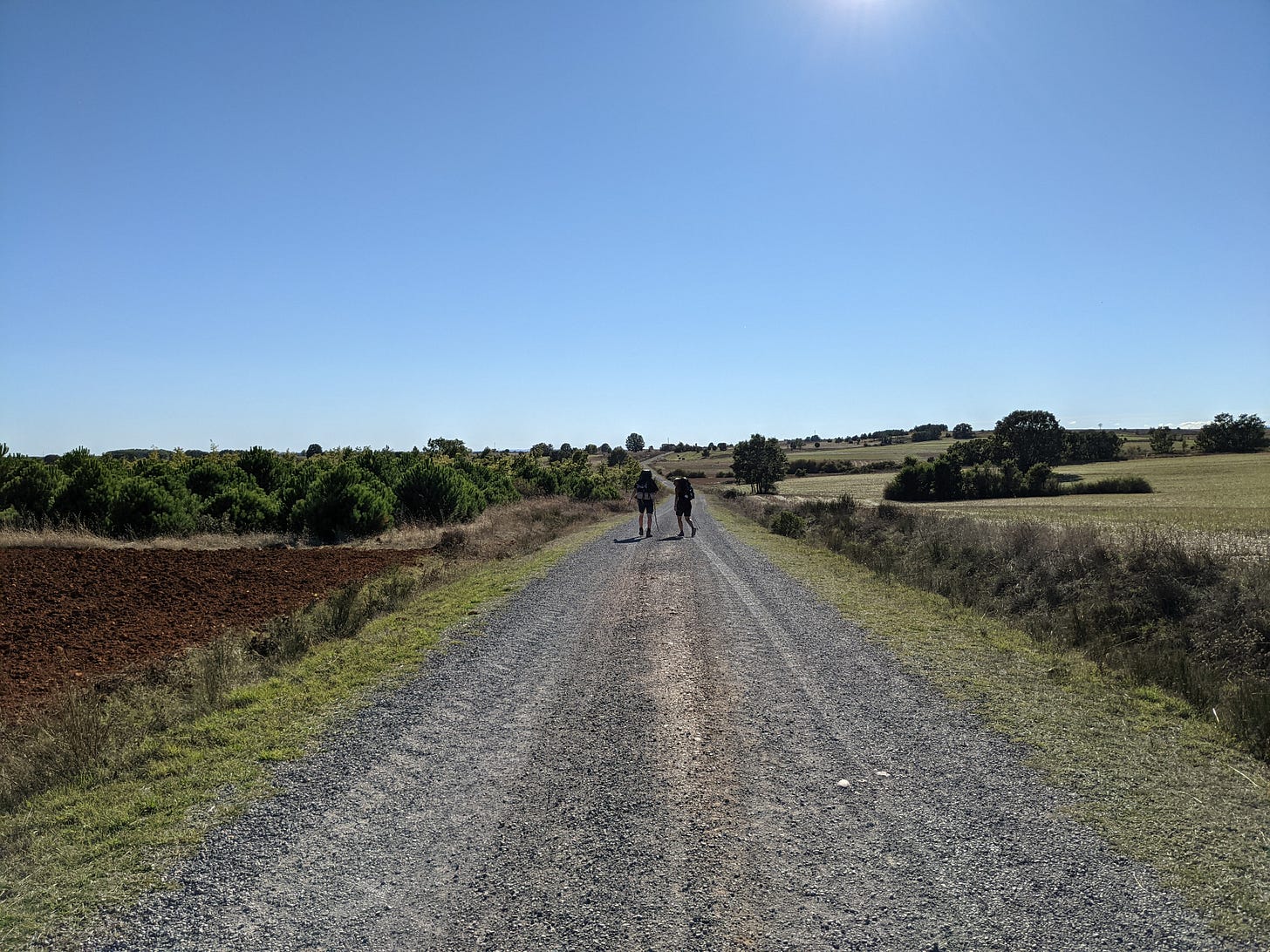I’m currently publishing a day-by-day account of my adventure on the Camino de Santiago. If you’d like to keep up with it, or if you’re interested in more stories and essays about travel, the outdoors, physical movement and the journeys they take us on, then Subscribe Now.
Your consciousness expands to your transcendent ideal as you journey into the unknown. Sure you have you destination, your map and your information, but you need to walk the path to see it all and to know it for yourself. We have all filled so much space in the last three weeks, and there’s more to come.
The fog of war is uncovered not by guidebooks and internet research and google maps but by the whispers of pilgrims, only days and hours in advance when appropriate. It is only when you walk through a place that your consciousness washes away the fog for real.
When you walk 25km with someone every day, your relationships grow at a speed that would take weeks at home. And if your relationships are the measure of yourself, then you will have grown at a similar rate. If you walk all the way to Santiago with them, you will have endured lifetimes together.
I leave the group after a late breakfast – we all just happened upon each other beside the cathedral, though it is on the Camino path after all. It’s good to meet up but it’s important to walk alone again, I think. Leaving this city feels like the ending of a chapter and the beginning of another, maybe even another book.
I take a few wrong turns before finding my way again, then hang out in a park for a bit. As I approach the first roundabout out of town I hear my name being shouted from across it, and furtive waves saying hello. It’s a few of the gang, again, of course. I join them for another coffee, maybe even another croissant.
“Tranquillo, tranquillo”, as they say around here.
It means “Take it easy”, “No rush”, “No worries”, or “Chill out” – whatever you want it to mean; tranquillo, tranquillo.
Compared to how I was pre-possessed with racing into early leads in the first week, and how it led to me being forced to slow down, taking the day entirely on your own terms, especially when the more self-serious pilgrims will say you should be out the door by 6am sharp every morning, feels like more of an exercise in conscious living – or so I tell myself.
We walk slowly out of Léon, and every time we reach another village, we stop and rest.
It’s a hot day, and we’re in no rush anywhere.
Some people hate the long walk through the suburbs that must follow the big cities – it can often take four or five kilometres before you’re out of the sprawl – though I have to say I always quite enjoy them. Like an elastic band of society that you’ve to push away from before you finally break free and you’re out into the world again.
La Virgen del Camino is about 7km outside of Léon. There’s another alternative route through the countryside that avoids the slightly shorter path running along the highway. This was another one of those choices in the route that people were fretting about in Léon last night: “Which way are you going?” Once again the differences were trivial, though I always choose the country path. The road winds upwards until we emerge out onto the Meseta again.
On paper it’s the same: a red dirt path headed nowhere going straight through flat farmland, under an enormous blue sky, some hedgerows here and there and the odd tractor, though little shade.
There is something different about it today though. Instead of a horizon that feels like it’s converging into a hidden destination, a limiting and chaotic freedom, the flat line of blue sky marks a border between the road and the far vaster Kingdom of Sky.
We may have been mentally funnelled through Léon in a sense; approaching for several days on the flat road that flanked a highway, the numbers slowly counting down in tens of kilometres, a milestone to reach but a millstone trapping us on a fixed point.
Here the same sky and land itself are far more open than they’ve ever been. The end is closer than ever, though compared to the last week of walking through this terrain and aching for some kind of destination in Léon, or anywhere, now it feels like we’ve been released, and are walking into our own freedom.
The road goes on forever. We walk for several hours. We rest when we feel like it. We share stories about our home countries. We ask questions, we play games, we play music. We pick stones out of our shoes. We talk and we erupt in laughter until tears form in our eyes.
If you’re enjoying this and think others will enjoy reading about my journey on the Camino, then why not share it?
I’ve often wondered whether I should be walking alone or not.
In fact, it’s a daily decision and I’ve come to the conclusion that it’s perhaps the ultimate decision on the Camino: to walk alone, or with others.
The great majority of the time I have been walking alone, unless perhaps I bump into someone as I walk. Funnily, the better I know someone the less likely we are to walk together, walking and talking is reserved by many for getting to know others.
It’s a different story when you break, when you lunch, when you find somewhere to stay for the evening. At this stage there’s always familiar faces around, or new ones – to be honest, it doesn’t even matter whether you know them or not, as it’s entirely possible you could happily spend your evening with a group of strangers, having those repetitive conversations, learning interesting things about the world and yourself, and enjoying yourself thoroughly.
The road has done its job so well at this stage – to open up those who talk it to the unknown and those they meet along the way – that it’s possible to ‘click’ very quickly with anyone, and if you both began in St. Jean then it feels like you’ve known them a long time; I found this to be accentuated if they’d began on the same day as me, funnily enough, as if time is another shared experience to bond over. It feels like you’ve known these people not since the day you met, but since the day you began the Camino.
All are stripped of their attachments and identities to their world at home by adopting the identity and purpose of the pilgrim, thus in knowing the path you’ve walked over the previous weeks, how long it took, the places you saw, how it affected your body and mind, and so on, you come to know all these things about the people you meet – and three weeks into the Camino, these are the only parts of their external identity that are left.
Like so many others I believed I came here for the solitary walking.
“It’s all about the people you meet” as I’d heard so, so often, even prior to coming here myself. It was the defining trait of the Camino that stuck out, from the accounts of others and basic internet research or cultural knowledge of the Camino. People say it quite a lot too in relation to travel more generally – seeing fleeting glimpses of generosity or hospitality from locals they’d come across over the few weeks they were backpacking around South East Asia or South America, though often it’d be in reference to the other backpackers they met on the same journey.
I’d always seen travel as a solo endeavour. This desire to escape normality and to witness things that would blow your tiny little mind, whether great mountain ranges of a scale you couldn’t comprehend, or old men sweeping dust into little piles outside their shop on a baking hot day.
Like many others I came here thinking I would do a lot of walking, see some beautiful scenery, soak up some of the charming Spanish culture, and have some pleasant conversations with people as I walked, and sure, some of them might be very interesting people from all sorts of interesting places. Ultimately though, I assumed that whatever ‘benefit’ or ‘positive changes’ I might get from the Camino would come from that time spent diligently walking alone, even enduring some kind of hardship or challenge in walking day after day, with no help or comfort from anyone.
In the early days I was steadfast in my desire to walk my own path, to assert my spiritual independence, not reliant on anyone else, nor having anyone rely on me, and not allowing others to dictate even the slightest detail of my trip. I must walk alone, and entirely in a manner of my own choosing. This is how one’s intuition – their connection with their spirit – is cultivated, and this is what the Camino is all about.
I even met people who’d tell me “It’s all about the people you meet” and quietly be thinking that they weren’t strong enough to assert their own independence, to keep walking their own path, so that it might reveal to them what they are looking for.
I think this was part of my drive in looking to go Beyond the ordinary – the typical, the popular, the familiar – by repeatedly psyching myself up for a 40km walk, just for the hell of it.
As one naturally-formed group dissolved and disappeared – each asserting their own choices in how to walk, generally in isolation, another seemed to appear to fill its place. There was no escaping it, until I turn around in Léon and a mega-group of pilgrims seems to have formed from many separate ones.
I’d still walk alone, others in small groups, though we knew the inevitability of when we’d arrive to accommodation, or meet each other at the same lunch spot, or bump into one another for breakfast. It was not so much a planned occurrence as an acceptance that we were all travelling together, whether we liked it or not.
Either my body or my mind refused to let me go any more or less far as I walked. Eventually I stopped trying to resist it, and just surrendered to the road. This was not how I’d planned to do my Camino, but this is what the Camino provided me. I was already a week behind schedule, though it turned out to be not only unfeasible but undesirable to go at the pace I’d planned back in Ireland, before I’d taken a step.
Everyone has to do the Camino in their own way, and it can only be decided what that is when you show up in St Jean.
And then on each day after, one day at a time, one step at a time.
The desire to journey alone is about vulnerability – putting yourself apart from society, exposing yourself to nature, the elements, even the opinions of the world you’ve left.
But you can practice that vulnerability by opening yourself up to that same world when you return to it.
At some point its better to deepen your connections rather than broaden your experiences.
We are all walking each other to Santiago, and all offering each other a space to be completely ourselves, whatever that form takes. Freed from the constraints and external identification of the places we’ve all come from, within in each of us is a person who listens, who shares, who connects, who laughs, who loves and who finds the world and its people incredibly beautiful, and we are all here together now, for whatever reason, but to give one another the space to express themselves, to walk however they want, and to support them when they need it.
To me, this is the true wonder of the Camino.
“We are all just walking each other home” – Ram Dass.
As we walk and talk and laugh all the way from Léon to wherever-the-hell-the-next-place-is, I no longer resist the group and try to walk away from it all just for the sake of it
I’ve never felt so free in my life.
If you’ve done the Camino, are thinking of doing it, or are just interested in discussing the Camino or travel in general - then please leave a comment. I’d love to hear from you.







